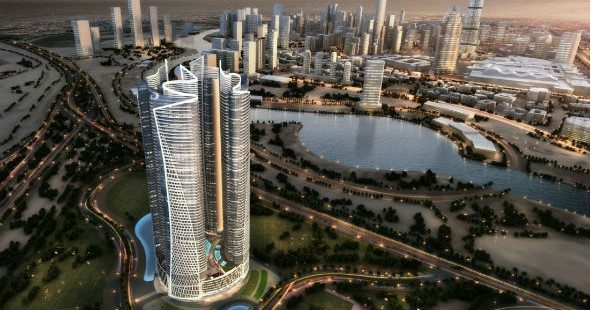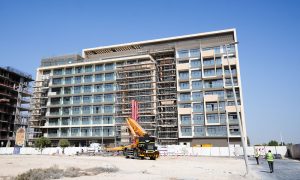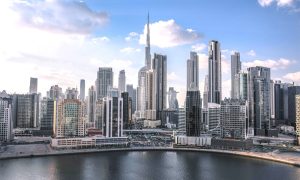Blockbuster in the Works
Gavin Davids visits the construction site of Damac Towers by Paramount

Dubai’s construction ambitions have always veered to the high life, with the city’s architecture reflecting an obsession with glitz and glamour. When driving down Sheikh Zayed Road, it can often feel like the city is part of a giant movie set. This image has been further reinforced by a number of Hollywood and Bollywood movies being set or shot in the city and amongst its landmarks.
Over the years, Dubai residents have seen Tom Cruise climb up the Burj Khalifa to save the world in Mission Impossible: Ghost Protocol, while George Clooney and Matt Damon have tackled the murky world of oil espionage from Dubai.
Even Bollywood has made regular use of the city to stage elaborate dance numbers and even the occasional coherent plot point.
However, what people weren’t expecting was a project that would bring one of Dubai’s most audacious developers into partnership with one of Hollywood’s most revered studios.
In March of 2013, Paramount Pictures, the studio that brought the world The Godfather and Indiana Jones, announced that it would be partnering with Damac Properties to launch its first ever luxury hotel property in Dubai.
The development of the hotel have been in motion since March 2012, when Paramount licensed their name and logo to a luxury hotel investment group. The company, subsequently named Paramount Hotels and Resorts, aims to build as many as 50 hotels around the world.
With such ambitious plans in place, it comes as no surprise that the project intends to live up to the hype generated by the announcement. Comprising of four 250m towers built around a common podium, the Damac Towers by Paramount will include 1,800 units of one, two and three bedroom serviced hotel rooms and residences spread across 70 storeys.
Built in the Burj Area of Downtown Dubai, the four towers are being constructed together in a punishing 33 month schedule. The expected completion date is in mid-June 2016. With construction only starting in September 2013, this presents a fairly formidable task for TAV Construction, the main contractor, as Nasser Fakhoury, assistant vice president for projects at Damac, explains.
“So far, work is progressing based on the agreed schedule. There have been changes to the design and additional work awarded to the contractor. The expected completion date might get delayed by about two months as the contractor is experiencing difficulties with a shortage of material suppliers like concrete and steel, which will pose a slight difficulty with progress,” he tells Big Project ME.
“Also, there’s the issue of labour. Qualified labour is not easy to find these days. These are the challenges we’re facing. Not just us, but most of the contractors here are facing these issues. Apart from these problems, everything else is moving smoothly and we’re working in accordance with the programme.”
In January of 2014, the construction team announced that it had completed the casting of the raft foundation for the project, which would allow work on the four towers to begin. More than 19,000 cubic metres of concrete and in excess of 2.2 metric tonnes of reinforced steel bars were used to construct the raft, Fakhoury says.
Since the completion of the raft, work on the towers has progressed fairly quickly, with the podium having reached the fifth level and work on the towers well underway.
While the design and construction of the towers on an individual basis may be fairly straight forward, the biggest complications come with the requirement that all four towers must be built together so as to meet the schedule.
In effect, Ugur Anliatamer of TAV Construction, is having to manage four sites as one. On its own, this would present quite a major challenge to most contractors, but what compounds their problems is that the site is situated between two of Dubai’s busiest road arteries – Al Khail Road and Al Awer Road.
“At the concept stage of this project, it was decided that all four towers would simultaneously move forwards. We’re trying to separate the podium areas and the towers themselves will move upwards to give us time to finish on time,” Anliatamer explains.
“The decision (to build all four towers together) is mainly because of the location of the project,” adds Fakhoury. “Logistically, there is a difficulty in terms of handling of materials, access to the site, providing storage and loading areas. We have challenges that we’re dealing with and we’re trying to cope with the challenges we’ve had so far.”
Both men agree that in order for the project to succeed and not get bogged down more than it already has, the need for cooperation between all stakeholders is absolutely crucial.
“It’s a joint-effort between the engineer, the client and the contractor. The contractor, from his side, is working on reinforcing his management style to provide sufficient teams for each tower, so that they act independently from the others. It’s not like you complete one tower and then move to another. The four of them have to go together. Our plan is to cast four slabs in six days.”
Sameer Abukhalil, senior manager for Projects at Damac, chimes in, pointing out that when it comes to logistics, a serious effort is being made by all stakeholders to ensure that work progresses as smoothly as possible onsite.
“We have here, day-to-day planning. As well as two week planning ahead, we also have six week planning. We have a live document which is updated every two weeks with the coming six months. This is just so we know when materials are coming on site and how they’re to be handled. This is so that when anything comes on site, there is no problem and it goes to the designated place without any issues.”
This care and attention to detail is second nature to TAV Construction, who have been one of the pioneers for BIM technology in the GCC.
“Of course, the logistical challenges is one of the prime factors. Even though our specifications do not state BIM requirements, what we’ve put in is our BIM team – who are a couple of people whose job it is to understand the project in more detail,” Anliatamer explains.
“We’ve introduced a BIM model as well, which gives us an advantage. You can elaborate and plan your activities sufficiently. And coordination wise, especially in MEP and civil coordination, by using the BIM model, you can understand more.”
Fakhoury adds that Damac Properties has been quick to get on board with this philosophy, pointing out that the developer has appointed a sub-consultant to handle BIM services and to keep an archive of work done on the site. He says that he hopes it will be used as a document management tool and then later on as planning management tool.
“BIM was introduced after the beginning of the project and it significantly impacted our project planning. The amount of information that we are taking as an output from BIM is huge and severe in its effect. The big thing is detecting those issues early and resolving them early. It gives us the privilege of moving fast without impacting the engineering or the work itself,” he explains.
Due to the constrained nature of the project, both in terms of physical space and time, this advanced planning and adaptability gave the team the opportunity to plan the project out properly and minimise wastage.
“BIM is not only a tool for engineering and for design coordination. It is also a tool that you can use to calculate the exact quantities of materials – like concrete, like steel, whatever you want to use. You can get exact, precise details. This will of course, give us an advantage during the procurement, logistic and planning stages,” Anliatamer says.
The team is so conscious about wasting time, they decided that despite having a concrete batching plant next to the project, they would also have a concrete supplier as a backup. With 200,000 cubic metres of concrete calculated to be used on the project, and steel at about 30,000 tonnes, it makes sense for these precautions to be taken.
Post tensioned systems are calculated to be at 440,000 square metres of area, while there is set to be 600,000 square metres of formwork.
“The other component is steel reinforcement. We are working with two backups from two companies. So far the challenge point in this market is deliveries, especially in such a fast track type of job. Deliveries should be precise and our logistics teams have to be organised,” Fakhoury points out.
“We organise and structure various disciplines – procurement, logistics and site deliveries. So first of all, with the procurement team, you’re investigating the markets as per the programme. The whole procurement is finalised based on that programme. And then afterwards, it goes to logistics and it’s a requirement of the site.
“Logistics is planning how to receive the materials and where it’s going to be stored. That’s another challenge, especially in Dubai. Everything is being occupied and that’s why you have to manage your storage efficiently,” he adds.
With 1,600 staff onsite at present, the need for planning ahead will only increase once peak construction time approaches.
By then, the team expects 4,000 workers to be onsite, including those from subcontractors who will be providing their own team and staff. All considered, by the time the project is in full swing, there will be 10 or more subcontractors operating onsite.
In addition to this, there will be 200 to 250 professional staff that will set up shop from TAV, along with 40-plus senior staff from consultants KEO and 20-plus staff members from Damac Properties itself.
With all these people involved in the project, health and safety management and onsite safety procedures are issues that TAV and Damac are not prepared to take lightly. As such, each tower has its own health and safety engineers, who are fully trained and certified, ABC says.
“No fatalities have been recorded, with no major accidents,” he asserts.
“Damac Properties have hired a safety team from the consultants just to make sure that all safety regulations are there, and to make sure that there are no safety hazards on this project. We also have our own safety team who come weekly to the site to make sure that things are progressing properly. It’s a team effort here (with regards to safety) and this is on all our projects,” Fakhoury points out.














